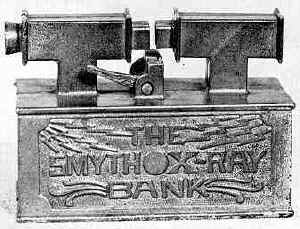Smyth X-Ray Bank
by F.H. Griffith - HOBBIES Magazine - April, 1961
 A mechanical bank commemorating a discovery of great benefit to
the entire world is our choice as No. 94 in the numerical classification of mechanical
banks. This bank is the Smyth X-Ray, and while it actually works on the principle of an
illusion, it does very properly convey in a broad sense the general principle of X-ray in
seeing through certain objects. The object in this case is a coin used in conjunction with
the operation of the bank.
A mechanical bank commemorating a discovery of great benefit to
the entire world is our choice as No. 94 in the numerical classification of mechanical
banks. This bank is the Smyth X-Ray, and while it actually works on the principle of an
illusion, it does very properly convey in a broad sense the general principle of X-ray in
seeing through certain objects. The object in this case is a coin used in conjunction with
the operation of the bank.
The Smyth X-Ray Bank was patented May 31, 1898 by Charles Smyth of Dayton, Ohio, and he assigned one half to Lena Hyman, also of Dayton. The patent papers are clear and concise in their description of his invention and the accompanying three drawings are exactly the same as the bank was actually made. The manufacturer of the bank is unknown, however, it is possible that Mr. Smyth had a foundry make the cast iron parts for him and then did the balance of the assembly work and so on either by himself or with employed help. It is also possible that some concern manufactured and marketed the bank for him, or he may have sold the patent outright to a company. In any event, perhaps at some future date the old catalog or advertisement will come to light which will reveal this information.
The bank shown is from the very fine collection of Mr. L.C. Hegarty and it is in excellent original condition. The bank was formerly in the collection of the late Dr. Arthur E. Corby, but just where Dr. Corby obtained it is unknown to the writer. This specimen has an oxidized type finish over its entire surface. However, the bank was apparently produced in at least two types of finishes as Mrs. Mary Gerken has in her collection a nickel plated Smyth X-Ray in fine original condition. These same two type finishes were also used on the Automatic Coin Savings Bank (HOBBIES, January 1957).
The name of the bank, as shown in the picture, also appears on the other side along with additional wording on the two T-shaped parts. One part has ‘Pat. Pending’ thereon, and the other ‘Trade Mark Rec’d.’. In each case the terminology appears on the horizontal side of the respective part. It is unusual to have Trade Mark on a mechanical bank, and particularly so in conjunction with a Patent reference. As the writer recalls there is only one other mechanical bank to bear both these inscriptions, the Little Jocko Musical Bank (HOBBIES, April 1960). The only Smyth X-Ray Banks seen by the writer to date all had ‘Pat. Pending’ thereon, and this would indicate they were all made while the patent was still pending. It is possible, however, even after the granting of the patent in 1898, that the terminology was never changed due to the fact it was felt the original Trade Mark was sufficient protection against infringement or duplication. In practically all cases where a mechanical bank was manufactured during the application or pending period of the patent term ‘Patent Pending’ or ‘Patent App’d. For’ was used on the bank. However, this was subsequently changed to the actual date of the issuance or granting of the patent and all future production of the particular bank bore this inscription.
The operation of the bank is simple but effective. A coin is placed in the center between the two T-shaped parts. It stays in position resting on the operating lever. The small tapered viewing section, shown on the left in the picture, is then raised to the eye of the viewer. With the other eye closed, the bank is held in this position and directed or pointed towards some well lighted object. The viewer sees the object as though he were looking right through the coin. The lever is then depressed, the coin drops into the bank, and the object still remains in the vision of the viewer. This is an illusion and actually the viewer is looking at an image or optical counterpart of the object. This illusion is created by the use of four mirrors, two small and two somewhat larger, arranged in such a fashion that they reflect the image down into and back up through the inside of the bank. The illusion principle of operation is employed in two other banks; one, the mechanical Presto Bank (HOBBIES, September 1956), and the other a semi-mechanical, the Multiplying Bank. The Multiplying Bank by the use of two mirrors set in a V-shape creates the illusion of making one penny look like eight.
In closing it bears mention that X-rays were discovered toward the end of 1895 by Wilhelm K. Roentgen, Professor of Physics at the University of Wurzburg, Bavaria. However, the first X-ray photograph was made January 12, 1896 by Dr. Henry Louis Smith, Professor of Physics at Davidson College in North Carolina. He used a human hand taken from a corpse and fired a bullet into it. He then took a 15 minute exposure which revealed the location of the bullet in the hand. It is of interest to note the coincidence of the similarity of names between the first user of X-rays and the inventor of the X-Ray Bank.
